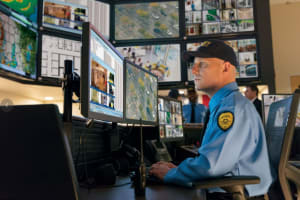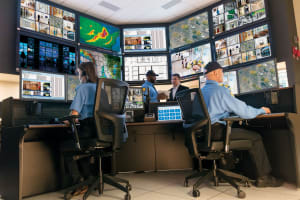10 Effective Measures for Enhancing Corporate Physical Security

It’s no secret: physical security is the foundation of a safe and productive workplace. While digital threats often dominate headlines, physical security risks — unauthorized access, theft, vandalism — pose equally significant dangers to businesses. As threats become more sophisticated, security leaders must move beyond basic locks and cameras to create an integrated approach that protects people, assets, and facilities.
Modern security strategies demand layered defenses, advanced technologies, and proactive policies to stay ahead of evolving risks and threats. From IoT-connected devices to insider threats, the challenges are complex, but the solutions can be transformative.
In this blog, we outline 10 essential measures every business can take to elevate their corporate physical security. With these insights, you’ll not only mitigate potential risks but also build a resilient security posture that supports operational excellence and peace of mind.
Key Takeaways
- Physical security requires a layered approach combining technology, personnel, and protocols to effectively protect modern businesses from evolving threats.
- The convergence of physical and digital security means vulnerabilities in one area can compromise the other, making integrated security solutions increasingly important.
- Regular security audits and employee training are as crucial as advanced technology in maintaining a robust security posture.
- Proactive security measures not only protect assets but also build trust with employees and customers while ensuring business continuity.
What is Corporate Physical Security?
Corporate physical security refers to the strategies, tools, and processes used to safeguard a company’s physical assets, employees, and facilities from external and internal threats. It encompasses access control systems, surveillance cameras, perimeter defenses, and employee training programs to minimize risks, prevent disruptions, and ensure compliance with security regulations.
Unlike cybersecurity, which focuses on digital threats, physical security protects tangible elements of an organization. However, the two are interconnected; weaknesses in physical security solutions can create opportunities for cyberattacks, and vice versa.
Why Physical Security Measures are Important for Businesses
Physical security measures are essential for protecting a business’s people, assets and reputation to avoid breaches and unplanned outages. Incidents such as theft, vandalism, or unauthorized access can cause costly disruptions, halting productivity and damaging customer trust. For instance, compromised facilities or stolen equipment can delay services and lead to financial losses far beyond the immediate incident. These risks are amplified for industries bound by strict regulations, such as finance, healthcare, and other critical infrastructure, where compliance failures could result in hefty fines or legal consequences.
Beyond financial impacts, strong physical security builds trust among employees and clients. Visible measures like access controls, ID verification, and security cameras reassure employees that their safety is a priority, creating a positive and productive workplace. Similarly, customers feel confident entrusting their data and assets to a business with robust security protocols.
What are Potential Risks in Corporate Physical Security?
Modern businesses face increasingly complex risks. Here’s a breakdown of the most pressing concerns:
Unauthorized Access
Unauthorized individuals gaining entry to secure areas can lead to theft, sabotage, or espionage. Tailgating — when someone follows an authorized individual through a secure entry point — is a particularly common risk in corporate settings.
Insider Threats
Employees, contractors, or vendors with authorized access can unintentionally or maliciously compromise security. Insider threats may include theft of sensitive data, sabotage. Negligence on the part of employees can put customer data at risk.
Physical Attacks
Acts of vandalism, sabotage, or targeted violence can disrupt operations, cause property damage, and put employees at risk.
Theft and Vandalism
Theft or unauthorized use of valuable equipment, intellectual property, or assets can significantly impact productivity and financial results. Vandalism can damage property, requiring costly repairs and delaying operations.
Cybersecurity Breaches
Physical vulnerabilities — such as leaving server rooms unsecured — can enable cyberattacks, blurring the line between physical and digital security risks. Compromised devices or hardware can serve as entry points for hackers. Similarly, not having proper controls and configurations on physical security devices leaves companies' IT infrastructure open to cyber attacks.
IoT Utilities
Internet of Things (IoT) devices like smart locks, sensors, printers, and cameras improve convenience but can create vulnerabilities if they are improperly secured. Without encryption and regular Firmware updates, these devices may become entry points for attackers.
10 Effective Measures to Strengthen Business Physical Security
Modern businesses require proactive strategies to address evolving security challenges. Below is a breakdown of the most effective measures organizations can implement to protect their people, assets, and operations.
1. Implement Access Control Systems
Modern access control systems ensure only authorized personnel can enter secure spaces. To gain access, they must authenticate their identity using a secure credential, such as a smart card, mobile credential, or biometric factor.
In addition to restricting access to sensitive areas, access control systems give security professionals the ability to manage access remotely and customize access levels, revoking or granting access at any time. These systems also keep real-time access logs, which are required for some compliance scenarios and help security teams identify unusual activity. Access control systems also become the main point of integration for many adjacent technologies, such as visitor management systems and vision analytics.
2. Install Surveillance Cameras
Surveillance cameras act as both a deterrent to bad actors and a tool for monitoring activity. Advanced options, like Honeywell Cameras, offer smart detection features, high-resolution recording, and real-time alerts to identify potential threats quickly and accurately.
3. Conduct Regular Security Audits
Frequent Physical and cybersecurity audits are vital for identifying vulnerabilities and ensuring protocols remain effective. Assessing entry points, reviewing access logs, and testing systems for compliance are key steps in this process.
4. Implement Employee Identification Systems
ID systems, such as employee badges or digital credentials, make it easier to identify authorized personnel and track movements within secure facilities. Pairing these systems with access logs enhances accountability and oversight.
5. Implement Perimeter Security Measures
Strong perimeter security is critical for deterring external threats. Fencing, gates, motion-activated lighting, and advanced sensors create a robust barrier against unauthorized access. Solutions that integrate perimeter monitoring with security management platforms allow near real-time alerts and enhanced protection for vulnerable areas.
6. Hire and Train Professional Security Teams
Trained security personnel provide on-site monitoring and immediate response to incidents and perform investigations when needed. Security teams should be equipped with modern tools and trained in areas like de-escalation, emergency response, forensic investigation, and surveillance system operations.
7. Install Intrusion Detection Systems
Intrusion detection systems detect unauthorized access, break-ins, or other security breaches in near real-time. Integrating alarms with surveillance and access control systems ensures full situational awareness and immediate response and minimizes losses.
8. Implement Emergency Response Plans
Well-documented emergency response plans ensure businesses are prepared for crises, including security breaches, active threats, or natural disasters. Regular drills and training sessions help employees respond effectively and minimize risk.
9. Regularly Update Security Procedures
As physical security threats continue to evolve, businesses must ensure their defenses keep pace. Regular updates to security equipment, software, firmware, and protocols are essential for staying ahead of emerging risks and threats. Security teams should prioritize upgrading outdated systems, applying necessary patches, and adopting the latest technologies to address vulnerabilities.
10. Create a Security Awareness and Training Protocol for Staff
Employee awareness is one of the most effective tools for maintaining security. Training programs empower employees to recognize potential threats, understand access control protocols, and report suspicious activity promptly. By developing a culture of vigilance, businesses can rely on their workforce as an additional layer of defense.
Enhance Your Corporate Physical Security Measures with LenelS2
The threat landscape for physical security is evolving rapidly, and your strategies must evolve alongside them. By leveraging modern technologies and integrated solutions, your organization can strengthen its defenses, protect its assets, and ensure operational continuity in the face of emerging risks.
Improving your security measures doesn’t have to be complicated. With LenelS2’s advanced services and support, you get access to expert guidance for system upgrades, proactive maintenance, and scalable enhancements that keep your security infrastructure future-ready. Additionally, with our access control solutions, you can easily manage and monitor access to your facilities in real time, ensuring that only authorized individuals have entry to critical areas.
Ready to take your physical security strategy to the next level? Contact LenelS2 today to learn how we can help you modernize your physical security approach.
Please note, the material provided is for informational purposes only, is general in nature, and is not intended to and should not be relied upon or construed as professional, medical or legal advice. Individuals and entities using or referencing the materials are encouraged to consult a professional regarding any specific circumstance. LenelS2 expressly disclaims all responsibility and shall have no liability for any damages, injuries of any kind or any liability whatsoever suffered as a result of your reliance on the information set forth in these materials.




